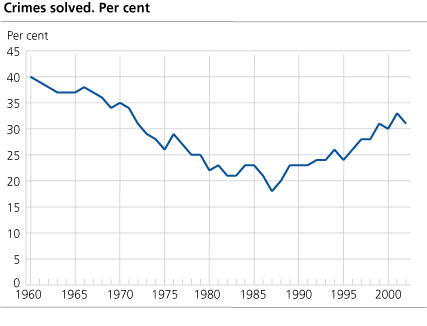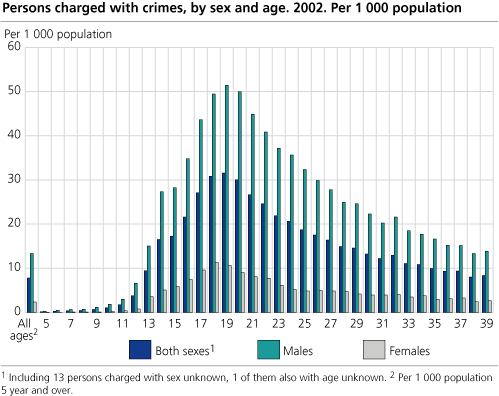Content
Published:
This is an archived release.
Less solved offences in the year of reform
The Police and prosecuting authorities completed investigation of 402 000 offences during 2002 - 5,6 percent less than in the previous year. The decrease was smaller for crime, and the percentage of solved crimes was at the same level as previous to the reform of the police districts.
The decrease compared to the previous year was about the same in number of misdemeanours and crime, but the percentage decrease was somewhat less for crime (3,8 per cent) than misdemeanours (10,4 per cent). The reduction in numbers regards to most types of offences. In total, the number of completed investigated sexual offences was the same as in 2001, while there were fewer crimes against property, narcotic crime and violence (see table). The decrease in the extent of offences settled legal in law, may possible have a certain connection to the police reform which took place during 2002 (see text box), but the statistics on completed investigated offences this year also has connection to the relatively lower number of registered offences reported to the police in 2001.32 per cent of the solved offences were registered as reported to the police before 2002.
| Crimes investigated, by group of crime. 1995-2002 |
| 1995 | 1996 | 1997 | 1998 | 1999 | 2000 | 2001 | 2002 | ||||||||||||||||||||||||||||||||
|---|---|---|---|---|---|---|---|---|---|---|---|---|---|---|---|---|---|---|---|---|---|---|---|---|---|---|---|---|---|---|---|---|---|---|---|---|---|---|---|
| Offences, total | 366 565 | 379 053 | 379 905 | 402 095 | 419 009 | 425 326 | 426 053 | 402 044 | |||||||||||||||||||||||||||||||
| Crime, total | 269 282 | 275 421 | 272 653 | 292 258 | 307 063 | 314 027 | 310 447 | 298 500 | |||||||||||||||||||||||||||||||
| Economic crime | 5 426 | 5 294 | 5 954 | 6 311 | 7 357 | 6 536 | 7 065 | 6 284 | |||||||||||||||||||||||||||||||
| Other crimes for profit | 202 104 | 200 008 | 193 282 | 205 908 | 210 813 | 212 542 | 201 746 | 196 679 | |||||||||||||||||||||||||||||||
| Crime of violence | 16 735 | 17 246 | 17 834 | 18 819 | 19 776 | 21 979 | 23 403 | 22 179 | |||||||||||||||||||||||||||||||
| Sexual crime | 2 026 | 2 593 | 3 921 | 2 828 | 2 824 | 2 689 | 2 498 | 2 422 | |||||||||||||||||||||||||||||||
| Crime of narcotics | 15 736 | 20 930 | 24 147 | 30 447 | 36 334 | 38 543 | 44 029 | 41 220 | |||||||||||||||||||||||||||||||
| Crime inflicting damage to property | 21 414 | 23 115 | 20 585 | 20 659 | 22 190 | 24 312 | 22 954 | 19 956 | |||||||||||||||||||||||||||||||
| Other crime1 | 5 841 | 6 235 | 6 930 | 7 286 | 7 769 | 7 426 | 8 752 | 9 760 | |||||||||||||||||||||||||||||||
| 1 | Including environment crimes. |
Percentage offences solved equals last three-year period
Almost 174 000 offences were solved, of which 62 000 resulted in ticket fines and 78 000 were committed for trial. In total, 43 per cent of all offences and 31 per cent of all crimes were solved. The percentage of crimes solved is somewhat lower than the previous year, but identical to the average in the three-year period 1999-2001. Compared to the last thirty years, only in 2001 a larger share of crimes were solved than in 2002 (see figure).
Most offences committed all by oneself ...
Of all solved offences where prosecuting authorities have registered perpetrators, less than five per cent has more than one person charged. How many persons who get caught after committing an offence together with others, will however vary a lot for the different types of offences. Robbery and blackmail are to the greatest extent carried out by several in cooperation, and in more than half of all solved cases of blackmailing there are more than one person charged. One fourth of all solved aggravated larcenies and crimes inflicting serious damage to property, are committed by more than one person.
New statistics give fewer offenders
13 per cent (9 400) of all persons charged in 2002 with a known citizenship, had foreign citizenship. More than half of these had permanent resident in Norway (54 per cent were registered with official Norwegian reference number), and one fourth of all foreigners charged had an official reference number from one of the other Scandinavian countries.
Statistics Norway has, from the statistics on offences investigated 2002 included, changed the method on identifying persons charged who has committed more than one offence. This change influence on all statistics on person charged, but is in first place of importance for the statistics on the assumed offenders citizenships. This new method involves that persons who commits offences under a temporarily residence in Norway, may be spoken of as "unregistered foreigners", now are being counted in the approximate same way as charged persons with permanent residences (see text box). This quality improvement must be included when considering development during a period of time among persons charged: In 2002 there were 22 per cent less charged persons with foreign citizenship than what appears from statistics for 2001, and almost all of this difference in number of persons charged can be explained by the change in method on identifying and counting the persons charged.
|
News on statistics on offences investigated 2002:
- New police districts replace the previous geographical division. The possibilities of comparing these to statistics on police districts how they were up to 1.1.2002, are to a great extent restricted. - Several persons charged without registered and valid official Norwegian reference number are being identified if they have committed more than one offence. This gives a somewhat lower number of persons charged, and a higher number of persons charged with more than one offence, for persons committing offences when on a temporarily residence in Norway in particular. - Statistics on the number of accessories , shows to a greater extent the actual number of offenders with who the person charged has committed the offence in cooperation with. This involves a somewhat higher number of accessories than it would have been out of the previous method of surveying these. - Transfers to Conflict Council is only made available as settlement valid in law only against persons charged over the age of consent. This involves that the number of transfers to Conflict Council becomes fewer, and that prosecutions dropped, because the offender is not liable, become correspondingly more. There has also been several other changes which has contributed to a quality improvement of the data basis and the statistics, something that to a greater extent will take effect in future volumes. The content in volumes from 2003 included will follow the same routines and definitions as for 2002-statistics, and will be published during the next months. |
Contact
-
Reid Jone Stene
E-mail: reid.jone.stene@ssb.no
tel.: (+47) 99 02 22 01
-
Siri Fjærtoft Fossanger
E-mail: siri.fossanger@ssb.no
tel.: (+47) 99 72 49 27
-
Sigmund Book Mohn
E-mail: sigmund.mohn@ssb.no
tel.: (+47) 94 32 77 22


